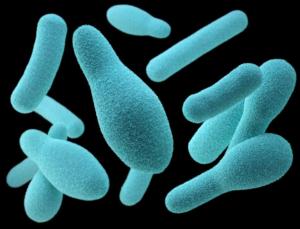
According to Mayo Clinic, Foodborne Pathogens Do Not Survive in Honey. Eating Raw Honey Safe in Pregnancy

Unlike raw dairy, meat or vegetables, raw honey poses no risk of infection or food poisoning. License: Creative Commmons
In general, pregnant women are advised to avoid eating raw foods that could cause illness due to bacterial infection. Raw honey is an exception.
However, pasteurization of honey has never been about food safety. Raw honey is extremely inhospitable to bacteria: they simply cannot survive in raw honey. This is why raw honey is such a remarkably safe natural food. Even stored for months to years at ambient temperatures, raw honey won’t spoil in a way that becomes harmful if eaten. Since bacteria cannot grow in raw honey, they cannot metabolize and produce toxins that could cause food poisoning. Similarly, people older than one year of age cannot get a bacterial infection from eating raw honey (more on infant botulism below).
Honey is pasteurized for the same reasons Louis Pasteur was originally pasteurizing wine: to kill harmless naturally occurring yeasts. In wine, these yeasts cause it to develop an unpleasant, sour taste. Raw honey also may also contain naturally occurring yeasts that can cause it to ferment if exposed to a humid environment. Notably these naturally occurring yeasts are absolutely harmless if consumed, but many people dislike the sour taste of fermented honey.
Honey packagers pasteurize honey to kill the harmless yeasts to prevent honey from fermenting over weeks to months after it’s opened and exposed to humid environments, like the average kitchen. Pasteurization also helps keep liquid honey from crystallizing, a natural process that occurs over weeks to months for most liquid honeys. Pasteurization of honey is all about shelf life and has nothing to do with food safety.
What about the fact that infants less than one year of age can contract infant botulism from eating honey?
It’s understandable this knowledge would lead pregnant women to avoid honey: if eating honey can harm an infant, wouldn’t it be harmful to the fetus? The short answer is “no”. An explanation of infant botulism will clarify. While bacteria cannot grow in raw honey, one bacterium, Clostridium botulinum, can exist in honey in a non-metabolic state referred to as an endospore. Endospores do not multiply or grow and are completely metabolically inactive. In honey, C. botulinum spores cannot produce the botulism toxin that can give adults or children potentially life-threatening food-borne botulism from eating spoiled foods containing botulism toxin produced by metabolically active C. botulinum bacteria. This used to be a serious issue with canned fruits, vegetables and meats as botulinum bacteria are found ubiquitously in natural soil and may contaminate those foods if not prepared hygienically.
Infant botulism caused by C. botulinum spores colonizing an infant's immature intestine is quite different than food-borne botulism that is caused by ingesting large loads of botulism toxin in spoiled foods. At birth, a baby’s intestines have not yet been exposed to or colonized by healthy bacteria (referred to as “normal intestinal flora”, or “healthy gut microbiome”) that are integral to normal intestinal functioning. These healthy bacteria break down some food components so that our intestines can digest and absorb them. They also prevent pathogenic bacteria such as C. botulinum from growing in our intestines. The intestines of individuals older than about 6-9 months (1 year of age is used as the honey cut-off to add a safety margin) have been colonized by healthy intestinal bacteria so they are not at risk of being colonized by C. botulinum spores and contracting infant botulism. The C. botulinum spores that may be present in honey simply cannot grow in the intestine of somebody older than one year of age. There is a theoretical risk that it might be possible for C. botulinum spores to colonize the intestines of an individual with either serious immune deficiencies or intestinal motility issues, but established cases of this are extremely rare (virtually unheard of in medical literature). Healthy adults are at no risk of being colonized by C. botulinum spores and hence no risk of contracting infant botulism or passing either the botulinum spores (which are not absorbed into the body) or botulism toxin (which does not exist in raw honey) to the fetus.
Pasteurizing honey does kill the harmless yeasts, but it does not kill any C. botulinum spores that may be present in the honey. Therefore, infants younger than one year of age should not eat any type of honey, raw or pasteurized. This is why pasteurized honey is no safer than raw honey. The heat of pasteurization does, however, diminish the health benefits of raw honey by destroying some of the natural enzymes, organic polyphenols and flavonoids that give raw honey its myriad of health benefits.
While honey is emphatically not “just another sugar” – the healthy effects of eating raw honey are almost the complete opposite of the health harms of eating excess processed sugars - honey is a carbohydrate that contains glucose and fructose. If a pregnant individual has diabetes, either prior to pregnancy, or as a complication of pregnancy, honey (raw or pasteurized) should be eaten only with careful monitoring of blood sugars in conjunction with a healthcare professional. Likewise, individuals at high risk of developing gestational diabetes (“diabetes of pregnancy”) or with a history of gestational diabetes should be cautious about honey consumption as they would be with any carbohydrate consumption. In healthy individuals, there is good scientific evidence that eating raw honey, especially if raw honey replaces dietary processed sugars, decreases the risk of developing diabetes.
Each pregnant individual must eat what she feels comfortable with. This article is an attempt to dispel some misunderstandings about raw honey and its safety for healthy pregnant women and anyone else concerned about the safety of raw honey.
Jeremy Wendell
Wendell Estate Honey
+1 204-564-2599
email us here
Visit us on social media:
Facebook
Instagram
YouTube
Tim & Isy Talk Raw Honey & Health
EIN Presswire does not exercise editorial control over third-party content provided, uploaded, published, or distributed by users of EIN Presswire. We are a distributor, not a publisher, of 3rd party content. Such content may contain the views, opinions, statements, offers, and other material of the respective users, suppliers, participants, or authors.



